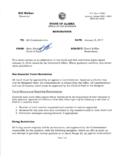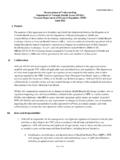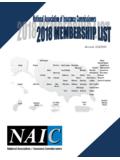Transcription of STATE AUDITOR TO REVIEW SNAP ADMINISTRATION
1 January 12, 2010 Contact: Celia Hagert, No. 10-430 STATE AUDITOR TO REVIEW SNAP ADMINISTRATION CPPP Recommends Comprehensive REVIEW of Staffing Needs, Business Processes, Technology, and Eligibility Policies Last month, the Texas Health and Human Services Commissioner Tom Suehs asked the Texas STATE AUDITOR to REVIEW the agency s Supplemental Nutrition Assistance Program (formerly known as the Food Stamp Program) operations and recommend changes to address the persistent and severe backlogs and delays in application processing, among other performance problems.
2 The audit presents a critical opportunity to investigate the root causes of the problems facing our eligibility system and identify solutions. This Policy Page outlines the problems, summarizes recent efforts to resolve them, identifies areas for further investigation, and offers potential solutions. We encourage the AUDITOR to look at business processes, technology, eligibility policies, and, most important, staffing. Given that Texas has a combined eligibility determination process for SNAP, Medicaid, and Temporary Assistance for Needy Families (which provides cash assistance and employment services), the problems undermining SNAP performance are also compromising access to health insurance and cash assistance.
3 Therefore, we urge the AUDITOR to expand his REVIEW to cover these programs as well. Background For the last four years, the Texas Health and Human Services Commission (HHSC) has struggled and fallen short of federal and STATE standards to provide accurate and timely service to needy Texans seeking assistance in caring for their families. While the economic downturn exacerbated the problem, the larger cause is chronic underfunding of our public benefits eligibility system and the attempt to privatize public benefits ADMINISTRATION in 2005.
4 At that time, HHSC also launched a new business model that made significant changes to the way clients apply for assistance through the use of call centers, a heavier reliance on technology and remote application options, and new partnerships with nonprofit organizations. Texas substantially reduced its public eligibility determination workforce in preparation for privatization; in addition to these layoffs, a significant number of highly experienced staff resigned. A four-month pilot of the system in early 2006 revealed technical difficulties, staffing shortages, and inadequate training of private call center staff.
5 Tens of thousands of needy Texans who rely on SNAP suffered through a frustrating enrollment process, were caught in long backlogs, and were often wrongly denied benefits. In 2007, Texas canceled the contract. Texas did not save any money in administrative costs and lost one-third of its public eligibility workforce in the process. Efforts to rebuild the eligibility system since 2007 have been stymied by inadequate funding for staff and technology, serious problems in the rollout of a new computer system (TIERS), and a lack of political will.
6 Despite modest increases in staff over the last two years, problems recruiting and retaining qualified staff continue to undermine performance, and delays in application processing, disruptions in benefits, and a high rate of improper denials persist today. The Center for Public Policy Priorities opposed rapid privatization and advocated a slower approach to modernization that involved adequate testing, reasonable timelines, and sufficient resources. Since the termination of the eligibility and enrollment contract, we have urged the 2 Texas Legislature to take the necessary steps to improve the performance of our eligibility system and restore SNAP access.
7 Timeline of Events 1999: Texas Legislature approves funding for new Texas Integrated Eligibility Redesign System (TIERS) computer system. July 2003: A pilot of TIERS is launched in two counties. December 2003: STATE officials delay rollout of TIERS due to problems identified during pilot. June 2003: Texas Legislature authorizes the use of privately run call centers as part of massive STATE budget cuts to health and human services. June 29, 2005: Texas signs contract with Accenture to take over development, ADMINISTRATION , and partial staffing of the eligibility and enrollment system.
8 January-April, 2006: New eligibility system is launched in two counties. More than 7,000 SNAP applications are caught in a backlog, and 127,000 children statewide lose Medicaid or CHIP. May 2006: STATE officials delay further rollout of privatized system indefinitely due to serious technical problems, massive backlogs, and inadequately trained contractor staff. Most application processing and eligibility determination functions are returned to STATE staff. January 2007: HHSC implements Medicaid family planning waiver (Women s Health Program) and decides to put WHP cases and associated SNAP/Medicaid cases in household into TIERS.
9 As a result, TIERS volume triples over the next year. March 2007: After legislative investigation, Governor cancels contract with Accenture. Texas Legislature increases funding for staff and makes bonuses available to retain staff. Delays in application processing persist. May 2008: FNS approves limited geographic rollout of TIERS, capped at 22 percent of the SNAP caseload. January 2009: HHSC completes conversion of Central Texas to TIERS, but halts further rollout due to staffing shortages, concerns over system capacity, and timeliness problems.
10 June 2009: Texas Legislature approves additional staff, but fails to authorize enough staff to bring workload down to acceptable levels. August 2008 present: Downturn in the economy and high turnover exacerbates staffing shortages; timeliness plunges, error rates skyrocket. August 2009: Class action lawsuit is filed against HHSC for failure to process SNAP applications within federal timeliness standards. September 2009: FNS sends HHSC an advance warning letter and demands a Corrective Action Plan. LBB approves 250 of the 650 additional staff requested by HHSC.





